Business Types, Structures, and External Factors for H&M Report
VerifiedAdded on 2023/01/05
|10
|2699
|21
Report
AI Summary
This report provides a comprehensive analysis of various business types, including micro, small, medium, and large businesses, along with their characteristics and examples. It also differentiates between various company types, such as sole traders, partnerships, limited liability businesses, public limited liability businesses, and co-operatives, illustrating each with relevant examples. Furthermore, the report explores different organizational structures like hierarchical, matrix, network, line, and team-based structures, focusing on their application within H&M. The report also includes a PESTLE analysis to evaluate the influence of external factors—political, economic, social, technological, legal, and environmental—on H&M's operations and future growth, highlighting the impact of these factors on the company's business strategies and market position. The conclusion summarizes the key findings and observations from the analysis.
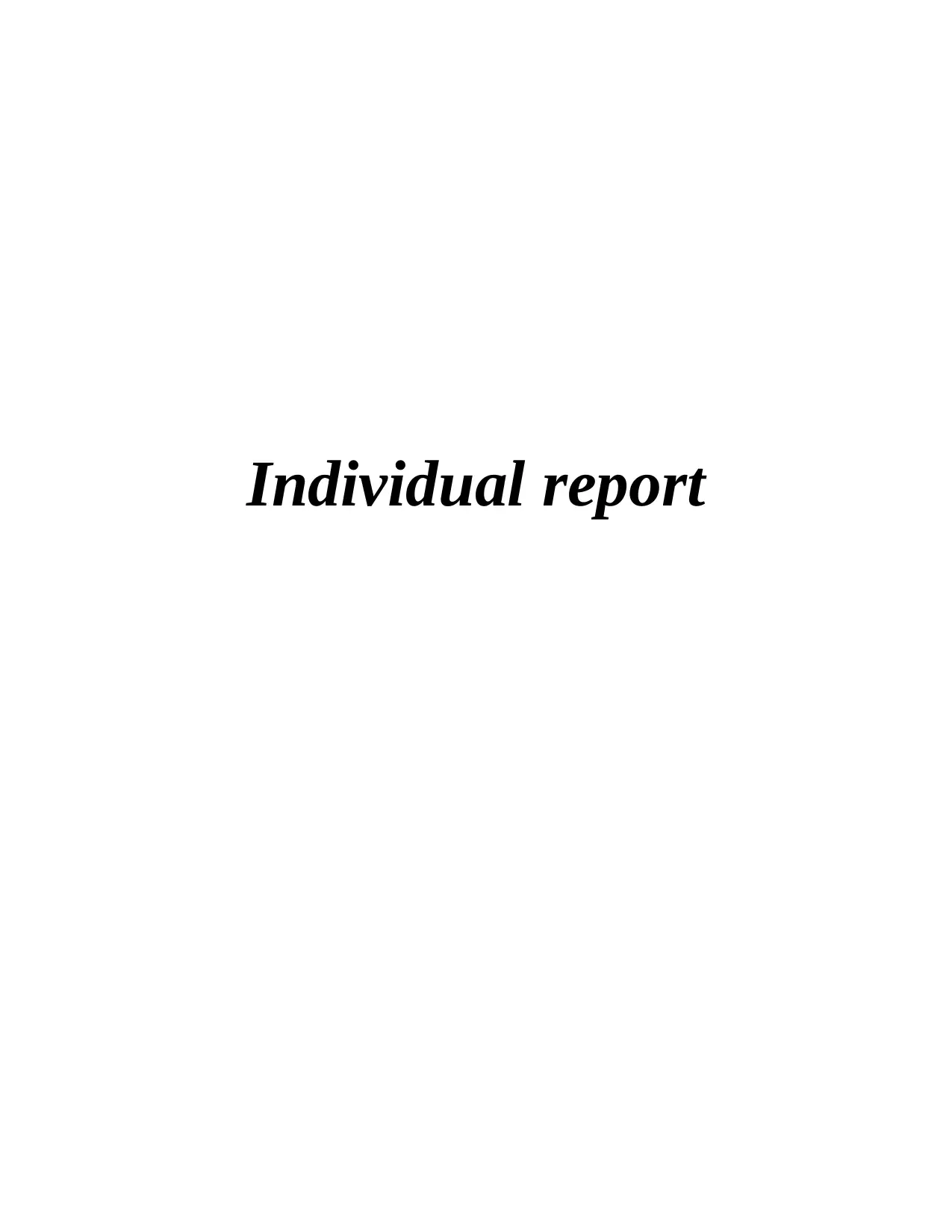
Individual report
Paraphrase This Document
Need a fresh take? Get an instant paraphrase of this document with our AI Paraphraser
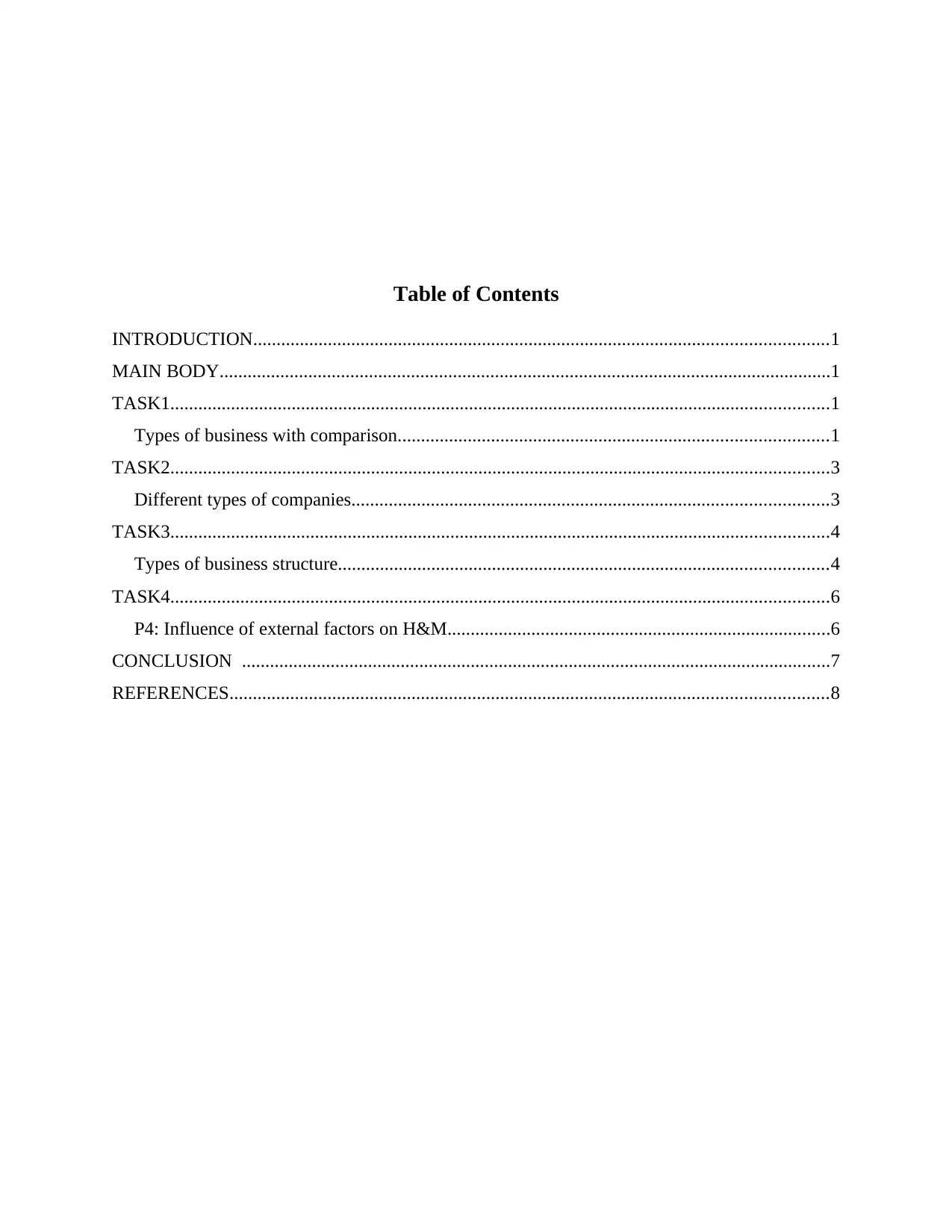
Table of Contents
INTRODUCTION...........................................................................................................................1
MAIN BODY...................................................................................................................................1
TASK1.............................................................................................................................................1
Types of business with comparison............................................................................................1
TASK2.............................................................................................................................................3
Different types of companies......................................................................................................3
TASK3.............................................................................................................................................4
Types of business structure.........................................................................................................4
TASK4.............................................................................................................................................6
P4: Influence of external factors on H&M..................................................................................6
CONCLUSION ..............................................................................................................................7
REFERENCES................................................................................................................................8
INTRODUCTION...........................................................................................................................1
MAIN BODY...................................................................................................................................1
TASK1.............................................................................................................................................1
Types of business with comparison............................................................................................1
TASK2.............................................................................................................................................3
Different types of companies......................................................................................................3
TASK3.............................................................................................................................................4
Types of business structure.........................................................................................................4
TASK4.............................................................................................................................................6
P4: Influence of external factors on H&M..................................................................................6
CONCLUSION ..............................................................................................................................7
REFERENCES................................................................................................................................8

INTRODUCTION
Business is refers as the enterprising entity or organisation, firm that involved in
professional, commercial and industrial activities for achievement of profit or non-profit firms
whose main motive is to serve society and solve social problems.
Business environment is defined as the combination of micro and macro factors that
impacts and influence operating & functioning of company (Business Environment Definition,
2020).
H&M is Sweden based multinational clothing retailer that deals in products such as-
clothing for men & women, children & teenagers. It is developed in 1947 by Stefan Persson with
its headquarter in Stockholm, Sweden. It has 171,000 employees and operates in 74 counties
with over 5000 stores.
In this report comparison between different types of business are considered with
characteristics and relevant examples. Further, differentiation between features, meaning of
several types of companies with considering suitable examples are discussed. In addition internal
and external factors on business are explained within the report.
MAIN BODY
TASK1
Types of business with comparison.
Micro business
Definition:- It is defined as the business that have one owner and 1 to 9 employees &
staff (Akhtar and Sushil, 2018). The annual revenue in micro business should be less than
$25,000. thus, a micro business is one who selecting formal business & legal structures such as-
LLC, corporation, partnership etc.
Characteristics:- The major fractures and characteristics of micro business are includes
higher shares in profit, less requirement of finance for monitoring and controlling of limited
employees.
Examples:- Caster Hill Fire Protection Ltd is based example of micro business in UK, it
develop fire protection goods and products with 145% growth turnover in last three years and
based in Issoria. Another example is WriteUpp with 209% turnover and dealing in healthcare
practices.
1
Business is refers as the enterprising entity or organisation, firm that involved in
professional, commercial and industrial activities for achievement of profit or non-profit firms
whose main motive is to serve society and solve social problems.
Business environment is defined as the combination of micro and macro factors that
impacts and influence operating & functioning of company (Business Environment Definition,
2020).
H&M is Sweden based multinational clothing retailer that deals in products such as-
clothing for men & women, children & teenagers. It is developed in 1947 by Stefan Persson with
its headquarter in Stockholm, Sweden. It has 171,000 employees and operates in 74 counties
with over 5000 stores.
In this report comparison between different types of business are considered with
characteristics and relevant examples. Further, differentiation between features, meaning of
several types of companies with considering suitable examples are discussed. In addition internal
and external factors on business are explained within the report.
MAIN BODY
TASK1
Types of business with comparison.
Micro business
Definition:- It is defined as the business that have one owner and 1 to 9 employees &
staff (Akhtar and Sushil, 2018). The annual revenue in micro business should be less than
$25,000. thus, a micro business is one who selecting formal business & legal structures such as-
LLC, corporation, partnership etc.
Characteristics:- The major fractures and characteristics of micro business are includes
higher shares in profit, less requirement of finance for monitoring and controlling of limited
employees.
Examples:- Caster Hill Fire Protection Ltd is based example of micro business in UK, it
develop fire protection goods and products with 145% growth turnover in last three years and
based in Issoria. Another example is WriteUpp with 209% turnover and dealing in healthcare
practices.
1
⊘ This is a preview!⊘
Do you want full access?
Subscribe today to unlock all pages.

Trusted by 1+ million students worldwide
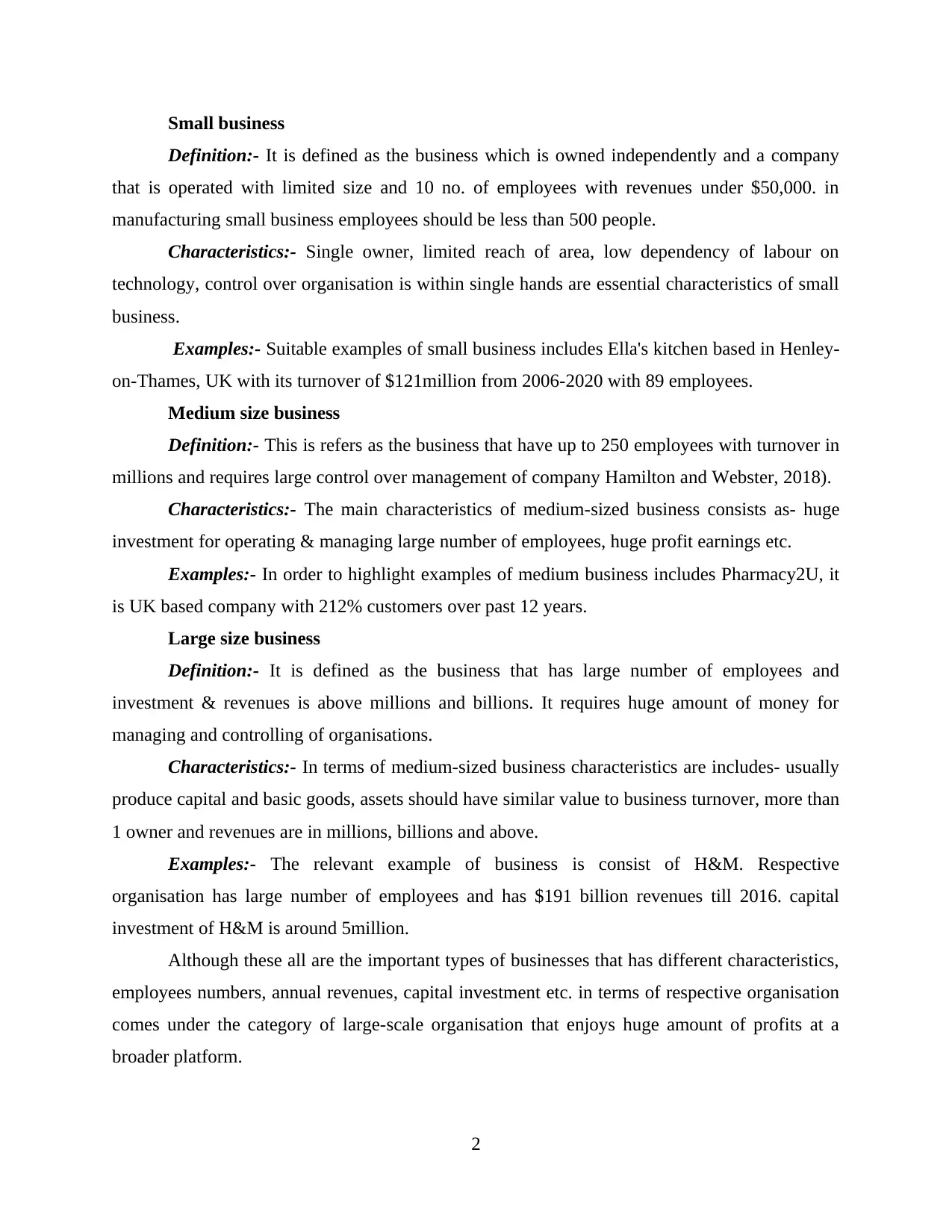
Small business
Definition:- It is defined as the business which is owned independently and a company
that is operated with limited size and 10 no. of employees with revenues under $50,000. in
manufacturing small business employees should be less than 500 people.
Characteristics:- Single owner, limited reach of area, low dependency of labour on
technology, control over organisation is within single hands are essential characteristics of small
business.
Examples:- Suitable examples of small business includes Ella's kitchen based in Henley-
on-Thames, UK with its turnover of $121million from 2006-2020 with 89 employees.
Medium size business
Definition:- This is refers as the business that have up to 250 employees with turnover in
millions and requires large control over management of company Hamilton and Webster, 2018).
Characteristics:- The main characteristics of medium-sized business consists as- huge
investment for operating & managing large number of employees, huge profit earnings etc.
Examples:- In order to highlight examples of medium business includes Pharmacy2U, it
is UK based company with 212% customers over past 12 years.
Large size business
Definition:- It is defined as the business that has large number of employees and
investment & revenues is above millions and billions. It requires huge amount of money for
managing and controlling of organisations.
Characteristics:- In terms of medium-sized business characteristics are includes- usually
produce capital and basic goods, assets should have similar value to business turnover, more than
1 owner and revenues are in millions, billions and above.
Examples:- The relevant example of business is consist of H&M. Respective
organisation has large number of employees and has $191 billion revenues till 2016. capital
investment of H&M is around 5million.
Although these all are the important types of businesses that has different characteristics,
employees numbers, annual revenues, capital investment etc. in terms of respective organisation
comes under the category of large-scale organisation that enjoys huge amount of profits at a
broader platform.
2
Definition:- It is defined as the business which is owned independently and a company
that is operated with limited size and 10 no. of employees with revenues under $50,000. in
manufacturing small business employees should be less than 500 people.
Characteristics:- Single owner, limited reach of area, low dependency of labour on
technology, control over organisation is within single hands are essential characteristics of small
business.
Examples:- Suitable examples of small business includes Ella's kitchen based in Henley-
on-Thames, UK with its turnover of $121million from 2006-2020 with 89 employees.
Medium size business
Definition:- This is refers as the business that have up to 250 employees with turnover in
millions and requires large control over management of company Hamilton and Webster, 2018).
Characteristics:- The main characteristics of medium-sized business consists as- huge
investment for operating & managing large number of employees, huge profit earnings etc.
Examples:- In order to highlight examples of medium business includes Pharmacy2U, it
is UK based company with 212% customers over past 12 years.
Large size business
Definition:- It is defined as the business that has large number of employees and
investment & revenues is above millions and billions. It requires huge amount of money for
managing and controlling of organisations.
Characteristics:- In terms of medium-sized business characteristics are includes- usually
produce capital and basic goods, assets should have similar value to business turnover, more than
1 owner and revenues are in millions, billions and above.
Examples:- The relevant example of business is consist of H&M. Respective
organisation has large number of employees and has $191 billion revenues till 2016. capital
investment of H&M is around 5million.
Although these all are the important types of businesses that has different characteristics,
employees numbers, annual revenues, capital investment etc. in terms of respective organisation
comes under the category of large-scale organisation that enjoys huge amount of profits at a
broader platform.
2
Paraphrase This Document
Need a fresh take? Get an instant paraphrase of this document with our AI Paraphraser
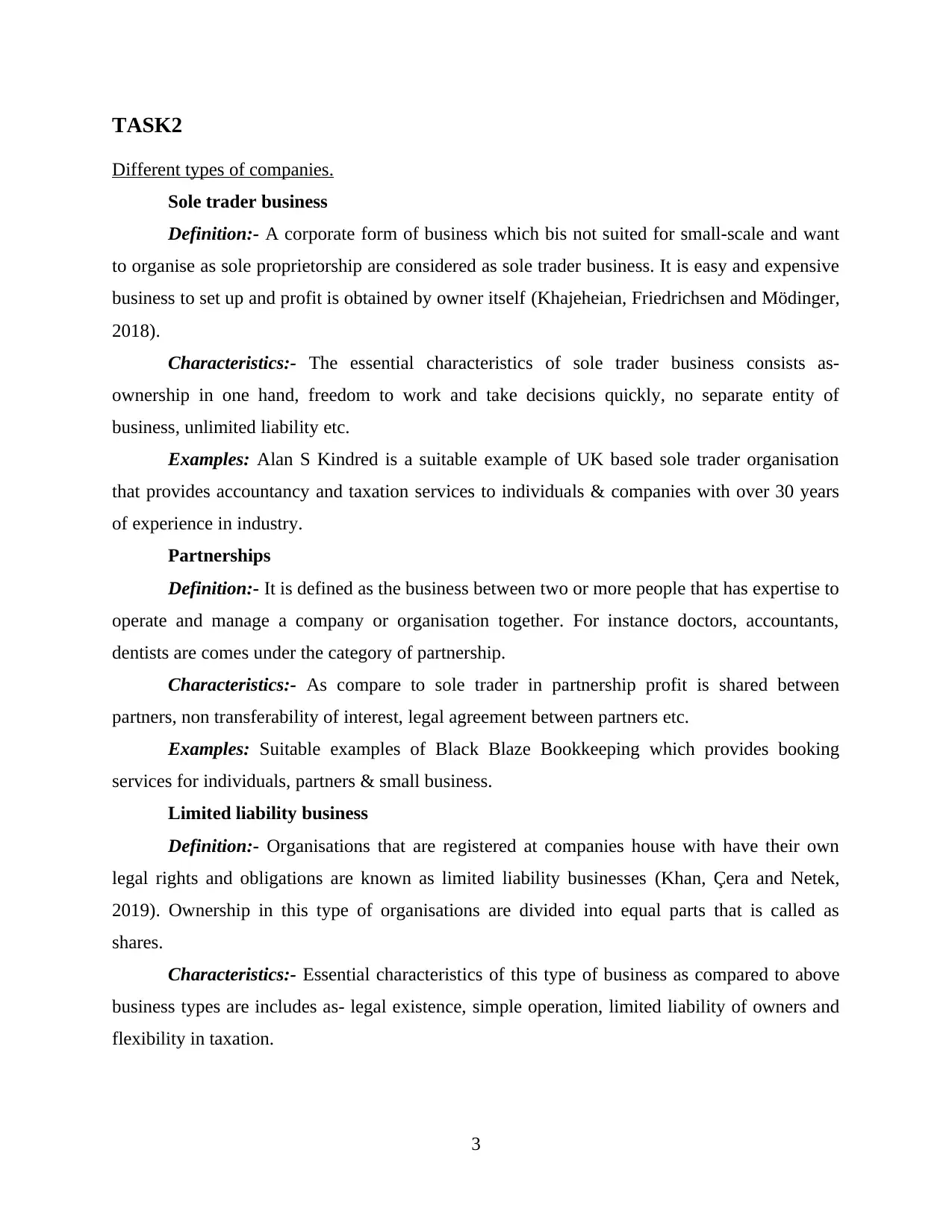
TASK2
Different types of companies.
Sole trader business
Definition:- A corporate form of business which bis not suited for small-scale and want
to organise as sole proprietorship are considered as sole trader business. It is easy and expensive
business to set up and profit is obtained by owner itself (Khajeheian, Friedrichsen and Mödinger,
2018).
Characteristics:- The essential characteristics of sole trader business consists as-
ownership in one hand, freedom to work and take decisions quickly, no separate entity of
business, unlimited liability etc.
Examples: Alan S Kindred is a suitable example of UK based sole trader organisation
that provides accountancy and taxation services to individuals & companies with over 30 years
of experience in industry.
Partnerships
Definition:- It is defined as the business between two or more people that has expertise to
operate and manage a company or organisation together. For instance doctors, accountants,
dentists are comes under the category of partnership.
Characteristics:- As compare to sole trader in partnership profit is shared between
partners, non transferability of interest, legal agreement between partners etc.
Examples: Suitable examples of Black Blaze Bookkeeping which provides booking
services for individuals, partners & small business.
Limited liability business
Definition:- Organisations that are registered at companies house with have their own
legal rights and obligations are known as limited liability businesses (Khan, Çera and Netek,
2019). Ownership in this type of organisations are divided into equal parts that is called as
shares.
Characteristics:- Essential characteristics of this type of business as compared to above
business types are includes as- legal existence, simple operation, limited liability of owners and
flexibility in taxation.
3
Different types of companies.
Sole trader business
Definition:- A corporate form of business which bis not suited for small-scale and want
to organise as sole proprietorship are considered as sole trader business. It is easy and expensive
business to set up and profit is obtained by owner itself (Khajeheian, Friedrichsen and Mödinger,
2018).
Characteristics:- The essential characteristics of sole trader business consists as-
ownership in one hand, freedom to work and take decisions quickly, no separate entity of
business, unlimited liability etc.
Examples: Alan S Kindred is a suitable example of UK based sole trader organisation
that provides accountancy and taxation services to individuals & companies with over 30 years
of experience in industry.
Partnerships
Definition:- It is defined as the business between two or more people that has expertise to
operate and manage a company or organisation together. For instance doctors, accountants,
dentists are comes under the category of partnership.
Characteristics:- As compare to sole trader in partnership profit is shared between
partners, non transferability of interest, legal agreement between partners etc.
Examples: Suitable examples of Black Blaze Bookkeeping which provides booking
services for individuals, partners & small business.
Limited liability business
Definition:- Organisations that are registered at companies house with have their own
legal rights and obligations are known as limited liability businesses (Khan, Çera and Netek,
2019). Ownership in this type of organisations are divided into equal parts that is called as
shares.
Characteristics:- Essential characteristics of this type of business as compared to above
business types are includes as- legal existence, simple operation, limited liability of owners and
flexibility in taxation.
3
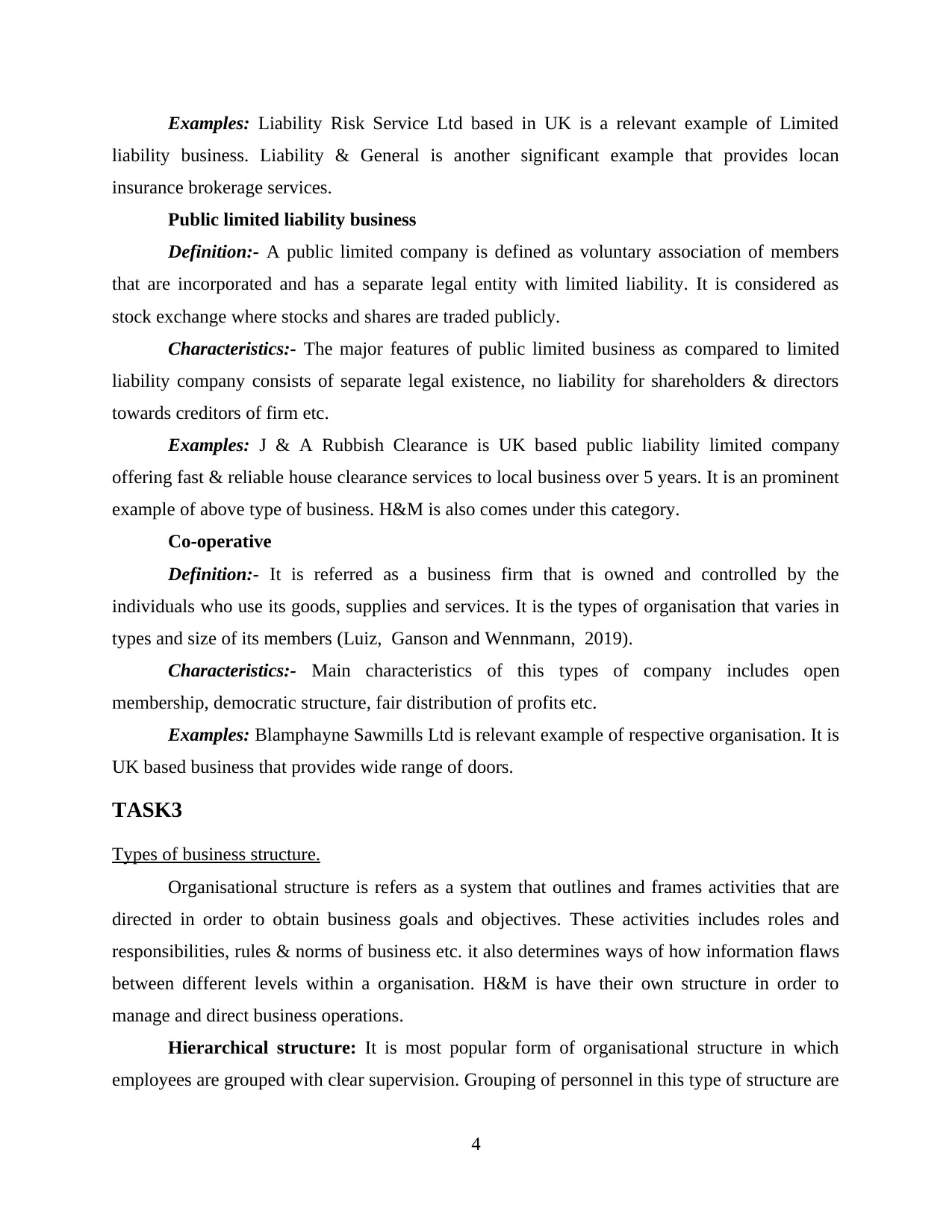
Examples: Liability Risk Service Ltd based in UK is a relevant example of Limited
liability business. Liability & General is another significant example that provides locan
insurance brokerage services.
Public limited liability business
Definition:- A public limited company is defined as voluntary association of members
that are incorporated and has a separate legal entity with limited liability. It is considered as
stock exchange where stocks and shares are traded publicly.
Characteristics:- The major features of public limited business as compared to limited
liability company consists of separate legal existence, no liability for shareholders & directors
towards creditors of firm etc.
Examples: J & A Rubbish Clearance is UK based public liability limited company
offering fast & reliable house clearance services to local business over 5 years. It is an prominent
example of above type of business. H&M is also comes under this category.
Co-operative
Definition:- It is referred as a business firm that is owned and controlled by the
individuals who use its goods, supplies and services. It is the types of organisation that varies in
types and size of its members (Luiz, Ganson and Wennmann, 2019).
Characteristics:- Main characteristics of this types of company includes open
membership, democratic structure, fair distribution of profits etc.
Examples: Blamphayne Sawmills Ltd is relevant example of respective organisation. It is
UK based business that provides wide range of doors.
TASK3
Types of business structure.
Organisational structure is refers as a system that outlines and frames activities that are
directed in order to obtain business goals and objectives. These activities includes roles and
responsibilities, rules & norms of business etc. it also determines ways of how information flaws
between different levels within a organisation. H&M is have their own structure in order to
manage and direct business operations.
Hierarchical structure: It is most popular form of organisational structure in which
employees are grouped with clear supervision. Grouping of personnel in this type of structure are
4
liability business. Liability & General is another significant example that provides locan
insurance brokerage services.
Public limited liability business
Definition:- A public limited company is defined as voluntary association of members
that are incorporated and has a separate legal entity with limited liability. It is considered as
stock exchange where stocks and shares are traded publicly.
Characteristics:- The major features of public limited business as compared to limited
liability company consists of separate legal existence, no liability for shareholders & directors
towards creditors of firm etc.
Examples: J & A Rubbish Clearance is UK based public liability limited company
offering fast & reliable house clearance services to local business over 5 years. It is an prominent
example of above type of business. H&M is also comes under this category.
Co-operative
Definition:- It is referred as a business firm that is owned and controlled by the
individuals who use its goods, supplies and services. It is the types of organisation that varies in
types and size of its members (Luiz, Ganson and Wennmann, 2019).
Characteristics:- Main characteristics of this types of company includes open
membership, democratic structure, fair distribution of profits etc.
Examples: Blamphayne Sawmills Ltd is relevant example of respective organisation. It is
UK based business that provides wide range of doors.
TASK3
Types of business structure.
Organisational structure is refers as a system that outlines and frames activities that are
directed in order to obtain business goals and objectives. These activities includes roles and
responsibilities, rules & norms of business etc. it also determines ways of how information flaws
between different levels within a organisation. H&M is have their own structure in order to
manage and direct business operations.
Hierarchical structure: It is most popular form of organisational structure in which
employees are grouped with clear supervision. Grouping of personnel in this type of structure are
4
⊘ This is a preview!⊘
Do you want full access?
Subscribe today to unlock all pages.

Trusted by 1+ million students worldwide
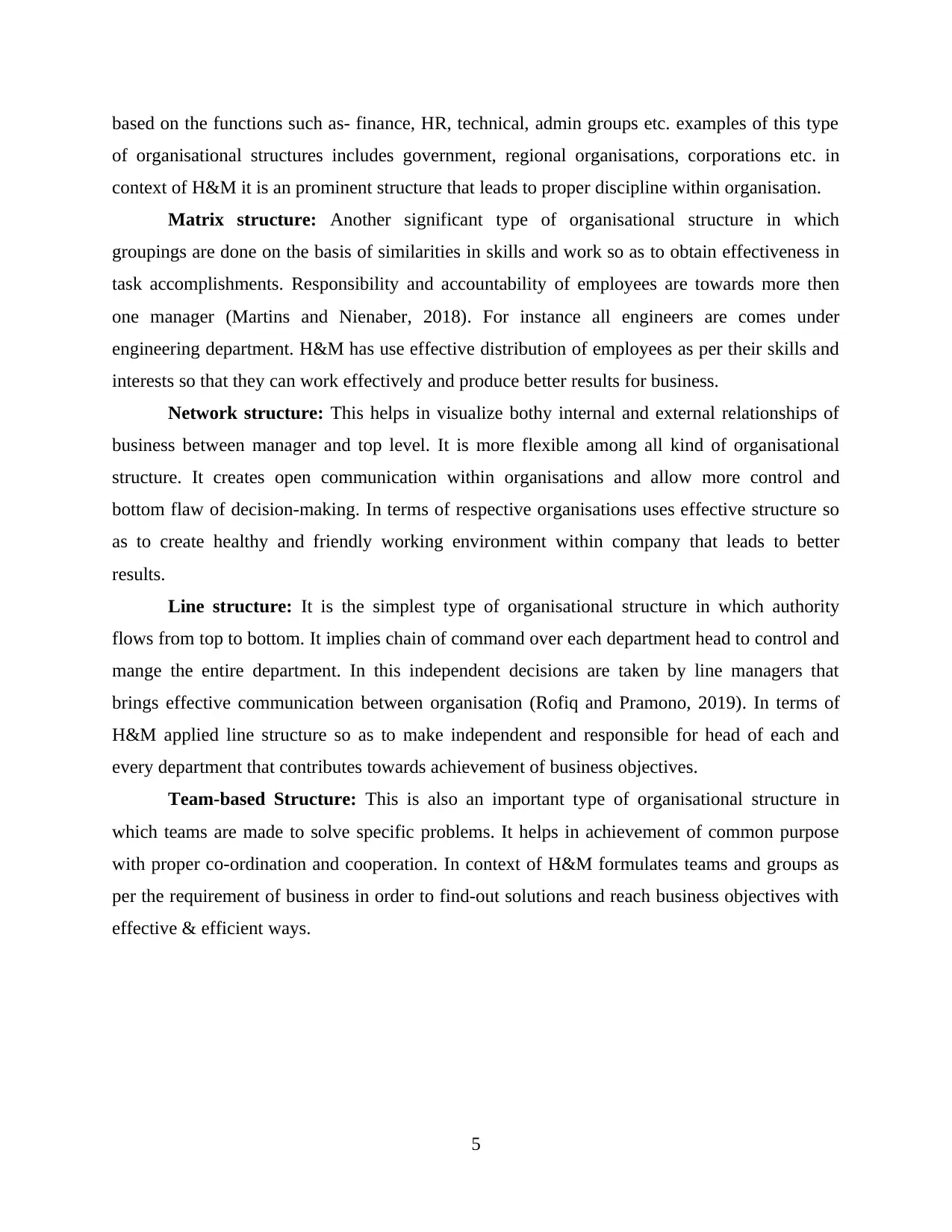
based on the functions such as- finance, HR, technical, admin groups etc. examples of this type
of organisational structures includes government, regional organisations, corporations etc. in
context of H&M it is an prominent structure that leads to proper discipline within organisation.
Matrix structure: Another significant type of organisational structure in which
groupings are done on the basis of similarities in skills and work so as to obtain effectiveness in
task accomplishments. Responsibility and accountability of employees are towards more then
one manager (Martins and Nienaber, 2018). For instance all engineers are comes under
engineering department. H&M has use effective distribution of employees as per their skills and
interests so that they can work effectively and produce better results for business.
Network structure: This helps in visualize bothy internal and external relationships of
business between manager and top level. It is more flexible among all kind of organisational
structure. It creates open communication within organisations and allow more control and
bottom flaw of decision-making. In terms of respective organisations uses effective structure so
as to create healthy and friendly working environment within company that leads to better
results.
Line structure: It is the simplest type of organisational structure in which authority
flows from top to bottom. It implies chain of command over each department head to control and
mange the entire department. In this independent decisions are taken by line managers that
brings effective communication between organisation (Rofiq and Pramono, 2019). In terms of
H&M applied line structure so as to make independent and responsible for head of each and
every department that contributes towards achievement of business objectives.
Team-based Structure: This is also an important type of organisational structure in
which teams are made to solve specific problems. It helps in achievement of common purpose
with proper co-ordination and cooperation. In context of H&M formulates teams and groups as
per the requirement of business in order to find-out solutions and reach business objectives with
effective & efficient ways.
5
of organisational structures includes government, regional organisations, corporations etc. in
context of H&M it is an prominent structure that leads to proper discipline within organisation.
Matrix structure: Another significant type of organisational structure in which
groupings are done on the basis of similarities in skills and work so as to obtain effectiveness in
task accomplishments. Responsibility and accountability of employees are towards more then
one manager (Martins and Nienaber, 2018). For instance all engineers are comes under
engineering department. H&M has use effective distribution of employees as per their skills and
interests so that they can work effectively and produce better results for business.
Network structure: This helps in visualize bothy internal and external relationships of
business between manager and top level. It is more flexible among all kind of organisational
structure. It creates open communication within organisations and allow more control and
bottom flaw of decision-making. In terms of respective organisations uses effective structure so
as to create healthy and friendly working environment within company that leads to better
results.
Line structure: It is the simplest type of organisational structure in which authority
flows from top to bottom. It implies chain of command over each department head to control and
mange the entire department. In this independent decisions are taken by line managers that
brings effective communication between organisation (Rofiq and Pramono, 2019). In terms of
H&M applied line structure so as to make independent and responsible for head of each and
every department that contributes towards achievement of business objectives.
Team-based Structure: This is also an important type of organisational structure in
which teams are made to solve specific problems. It helps in achievement of common purpose
with proper co-ordination and cooperation. In context of H&M formulates teams and groups as
per the requirement of business in order to find-out solutions and reach business objectives with
effective & efficient ways.
5
Paraphrase This Document
Need a fresh take? Get an instant paraphrase of this document with our AI Paraphraser
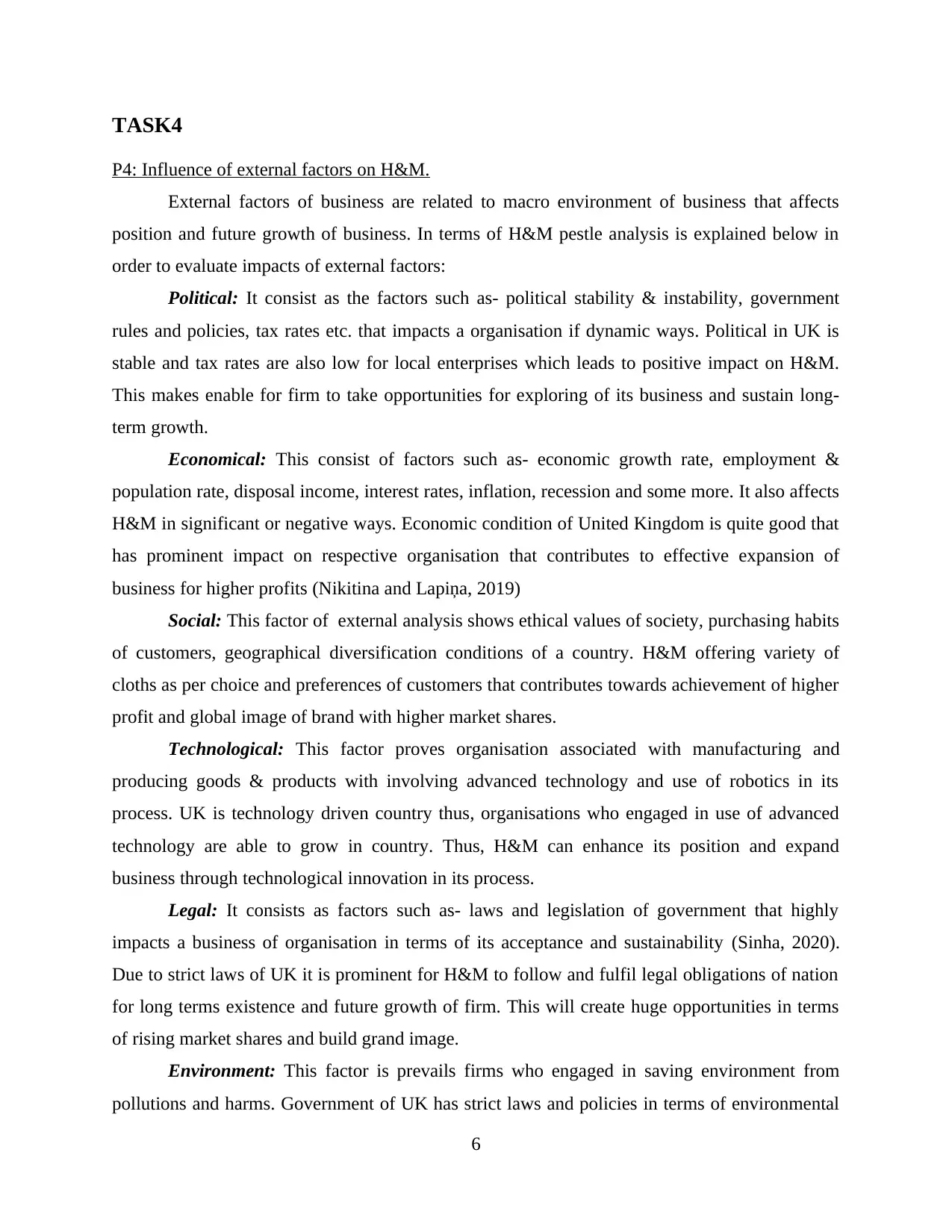
TASK4
P4: Influence of external factors on H&M.
External factors of business are related to macro environment of business that affects
position and future growth of business. In terms of H&M pestle analysis is explained below in
order to evaluate impacts of external factors:
Political: It consist as the factors such as- political stability & instability, government
rules and policies, tax rates etc. that impacts a organisation if dynamic ways. Political in UK is
stable and tax rates are also low for local enterprises which leads to positive impact on H&M.
This makes enable for firm to take opportunities for exploring of its business and sustain long-
term growth.
Economical: This consist of factors such as- economic growth rate, employment &
population rate, disposal income, interest rates, inflation, recession and some more. It also affects
H&M in significant or negative ways. Economic condition of United Kingdom is quite good that
has prominent impact on respective organisation that contributes to effective expansion of
business for higher profits (Nikitina and Lapiņa, 2019)
Social: This factor of external analysis shows ethical values of society, purchasing habits
of customers, geographical diversification conditions of a country. H&M offering variety of
cloths as per choice and preferences of customers that contributes towards achievement of higher
profit and global image of brand with higher market shares.
Technological: This factor proves organisation associated with manufacturing and
producing goods & products with involving advanced technology and use of robotics in its
process. UK is technology driven country thus, organisations who engaged in use of advanced
technology are able to grow in country. Thus, H&M can enhance its position and expand
business through technological innovation in its process.
Legal: It consists as factors such as- laws and legislation of government that highly
impacts a business of organisation in terms of its acceptance and sustainability (Sinha, 2020).
Due to strict laws of UK it is prominent for H&M to follow and fulfil legal obligations of nation
for long terms existence and future growth of firm. This will create huge opportunities in terms
of rising market shares and build grand image.
Environment: This factor is prevails firms who engaged in saving environment from
pollutions and harms. Government of UK has strict laws and policies in terms of environmental
6
P4: Influence of external factors on H&M.
External factors of business are related to macro environment of business that affects
position and future growth of business. In terms of H&M pestle analysis is explained below in
order to evaluate impacts of external factors:
Political: It consist as the factors such as- political stability & instability, government
rules and policies, tax rates etc. that impacts a organisation if dynamic ways. Political in UK is
stable and tax rates are also low for local enterprises which leads to positive impact on H&M.
This makes enable for firm to take opportunities for exploring of its business and sustain long-
term growth.
Economical: This consist of factors such as- economic growth rate, employment &
population rate, disposal income, interest rates, inflation, recession and some more. It also affects
H&M in significant or negative ways. Economic condition of United Kingdom is quite good that
has prominent impact on respective organisation that contributes to effective expansion of
business for higher profits (Nikitina and Lapiņa, 2019)
Social: This factor of external analysis shows ethical values of society, purchasing habits
of customers, geographical diversification conditions of a country. H&M offering variety of
cloths as per choice and preferences of customers that contributes towards achievement of higher
profit and global image of brand with higher market shares.
Technological: This factor proves organisation associated with manufacturing and
producing goods & products with involving advanced technology and use of robotics in its
process. UK is technology driven country thus, organisations who engaged in use of advanced
technology are able to grow in country. Thus, H&M can enhance its position and expand
business through technological innovation in its process.
Legal: It consists as factors such as- laws and legislation of government that highly
impacts a business of organisation in terms of its acceptance and sustainability (Sinha, 2020).
Due to strict laws of UK it is prominent for H&M to follow and fulfil legal obligations of nation
for long terms existence and future growth of firm. This will create huge opportunities in terms
of rising market shares and build grand image.
Environment: This factor is prevails firms who engaged in saving environment from
pollutions and harms. Government of UK has strict laws and policies in terms of environmental
6
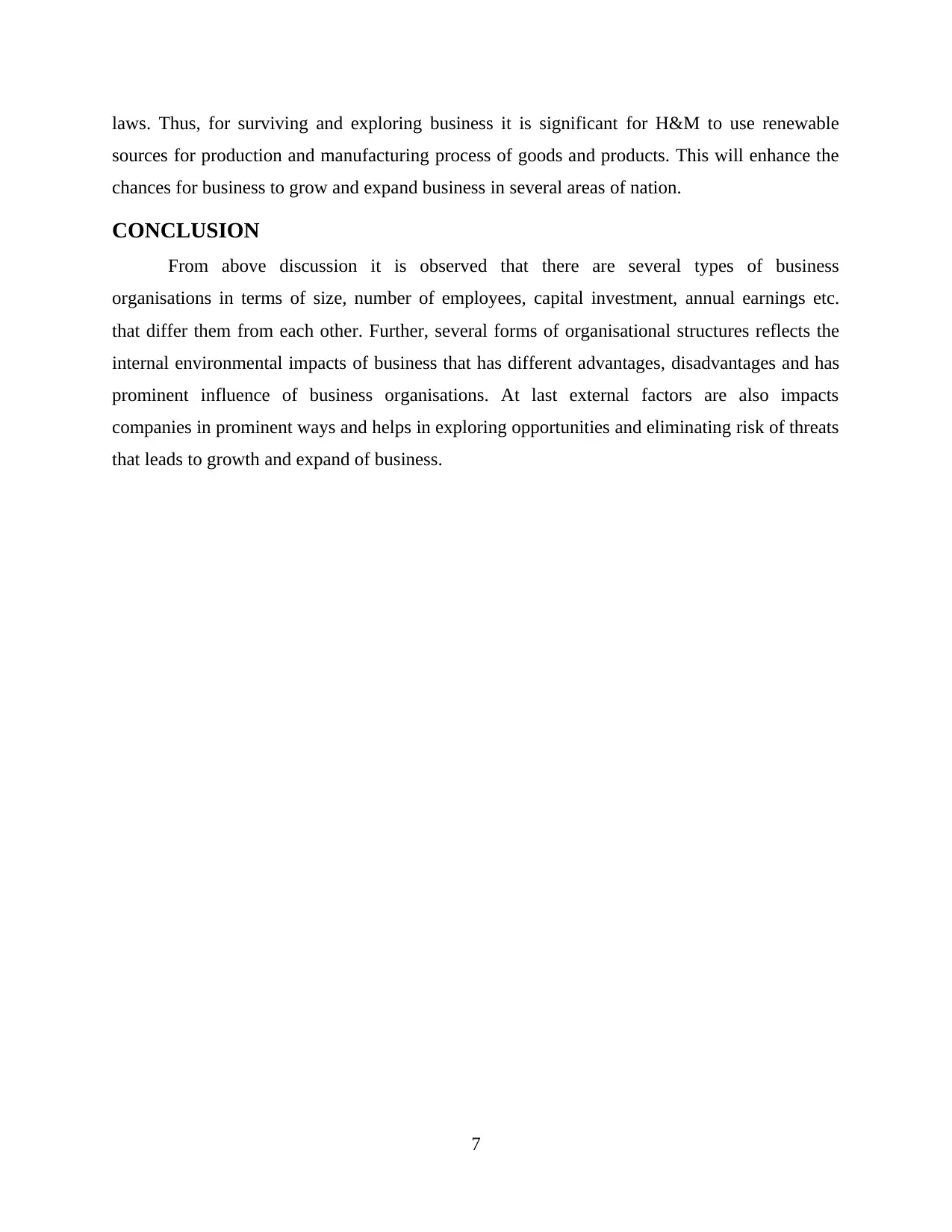
laws. Thus, for surviving and exploring business it is significant for H&M to use renewable
sources for production and manufacturing process of goods and products. This will enhance the
chances for business to grow and expand business in several areas of nation.
CONCLUSION
From above discussion it is observed that there are several types of business
organisations in terms of size, number of employees, capital investment, annual earnings etc.
that differ them from each other. Further, several forms of organisational structures reflects the
internal environmental impacts of business that has different advantages, disadvantages and has
prominent influence of business organisations. At last external factors are also impacts
companies in prominent ways and helps in exploring opportunities and eliminating risk of threats
that leads to growth and expand of business.
7
sources for production and manufacturing process of goods and products. This will enhance the
chances for business to grow and expand business in several areas of nation.
CONCLUSION
From above discussion it is observed that there are several types of business
organisations in terms of size, number of employees, capital investment, annual earnings etc.
that differ them from each other. Further, several forms of organisational structures reflects the
internal environmental impacts of business that has different advantages, disadvantages and has
prominent influence of business organisations. At last external factors are also impacts
companies in prominent ways and helps in exploring opportunities and eliminating risk of threats
that leads to growth and expand of business.
7
⊘ This is a preview!⊘
Do you want full access?
Subscribe today to unlock all pages.

Trusted by 1+ million students worldwide
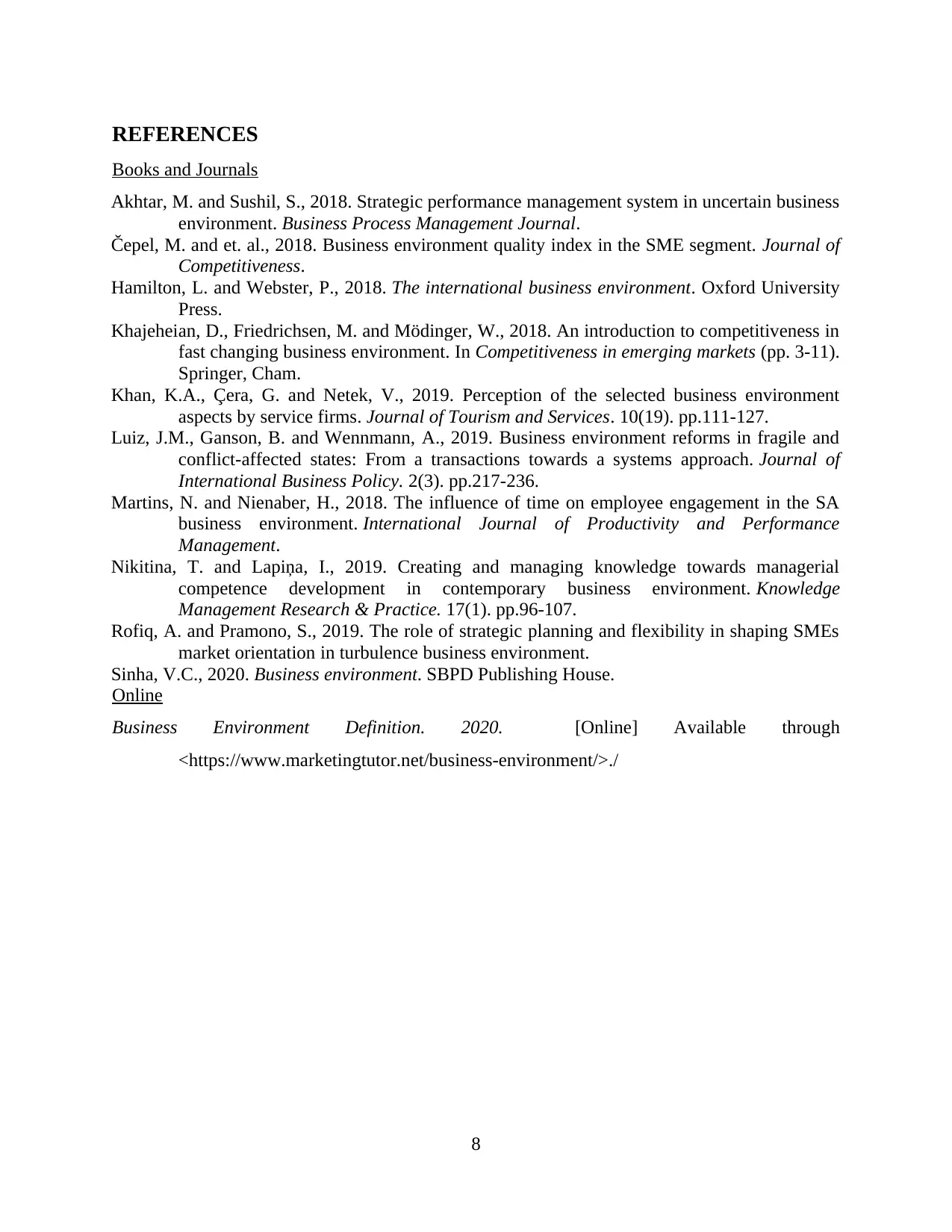
REFERENCES
Books and Journals
Akhtar, M. and Sushil, S., 2018. Strategic performance management system in uncertain business
environment. Business Process Management Journal.
Čepel, M. and et. al., 2018. Business environment quality index in the SME segment. Journal of
Competitiveness.
Hamilton, L. and Webster, P., 2018. The international business environment. Oxford University
Press.
Khajeheian, D., Friedrichsen, M. and Mödinger, W., 2018. An introduction to competitiveness in
fast changing business environment. In Competitiveness in emerging markets (pp. 3-11).
Springer, Cham.
Khan, K.A., Çera, G. and Netek, V., 2019. Perception of the selected business environment
aspects by service firms. Journal of Tourism and Services. 10(19). pp.111-127.
Luiz, J.M., Ganson, B. and Wennmann, A., 2019. Business environment reforms in fragile and
conflict-affected states: From a transactions towards a systems approach. Journal of
International Business Policy. 2(3). pp.217-236.
Martins, N. and Nienaber, H., 2018. The influence of time on employee engagement in the SA
business environment. International Journal of Productivity and Performance
Management.
Nikitina, T. and Lapiņa, I., 2019. Creating and managing knowledge towards managerial
competence development in contemporary business environment. Knowledge
Management Research & Practice. 17(1). pp.96-107.
Rofiq, A. and Pramono, S., 2019. The role of strategic planning and flexibility in shaping SMEs
market orientation in turbulence business environment.
Sinha, V.C., 2020. Business environment. SBPD Publishing House.
Online
Business Environment Definition. 2020. [Online] Available through
<https://www.marketingtutor.net/business-environment/>./
8
Books and Journals
Akhtar, M. and Sushil, S., 2018. Strategic performance management system in uncertain business
environment. Business Process Management Journal.
Čepel, M. and et. al., 2018. Business environment quality index in the SME segment. Journal of
Competitiveness.
Hamilton, L. and Webster, P., 2018. The international business environment. Oxford University
Press.
Khajeheian, D., Friedrichsen, M. and Mödinger, W., 2018. An introduction to competitiveness in
fast changing business environment. In Competitiveness in emerging markets (pp. 3-11).
Springer, Cham.
Khan, K.A., Çera, G. and Netek, V., 2019. Perception of the selected business environment
aspects by service firms. Journal of Tourism and Services. 10(19). pp.111-127.
Luiz, J.M., Ganson, B. and Wennmann, A., 2019. Business environment reforms in fragile and
conflict-affected states: From a transactions towards a systems approach. Journal of
International Business Policy. 2(3). pp.217-236.
Martins, N. and Nienaber, H., 2018. The influence of time on employee engagement in the SA
business environment. International Journal of Productivity and Performance
Management.
Nikitina, T. and Lapiņa, I., 2019. Creating and managing knowledge towards managerial
competence development in contemporary business environment. Knowledge
Management Research & Practice. 17(1). pp.96-107.
Rofiq, A. and Pramono, S., 2019. The role of strategic planning and flexibility in shaping SMEs
market orientation in turbulence business environment.
Sinha, V.C., 2020. Business environment. SBPD Publishing House.
Online
Business Environment Definition. 2020. [Online] Available through
<https://www.marketingtutor.net/business-environment/>./
8
1 out of 10
Related Documents
Your All-in-One AI-Powered Toolkit for Academic Success.
+13062052269
info@desklib.com
Available 24*7 on WhatsApp / Email
![[object Object]](/_next/static/media/star-bottom.7253800d.svg)
Unlock your academic potential
Copyright © 2020–2025 A2Z Services. All Rights Reserved. Developed and managed by ZUCOL.





